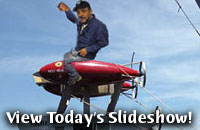| Daily Updates: May
2003 |
| S | M | T | W | T | F | S |
| |
|
|
|
1 |
2 |
3 |
| 4 |
5 |
6 |
7 |
8 |
9 |
10 |
| 11 |
12 |
13 |
14 |
15 |
16 |
17 |
| 18 |
19 |
20 |
21 |
22 |
23 |
24 |
| 25 |
26 |
27 |
28 |
29 |
30 |
31 |
| Daily Updates: June
2003 |
| S |
M |
T |
W |
T |
F |
S |
| 1 |
2 |
3 |
4 |
5 |
6 |
7 |
| 8 |
9 |
10 |
11 |
12 |
13 |
14 |
| 15 |
16 |
17 |
18 |
19 |
20 |
21 |
| 22 |
23 |
24 |
25 |
26 |
27 |
28 |
| 29 |
30 |
|
|
|
|
|


TODAY'S WEATHER
Partly Cloudy
74°F (23.3°C)
Latitude: 38° 57'N
Longitude: 61° 02'W
Wind Direction: WNW
Wind Speed: 12 Knots
Sea State: 2
Sea Temperature: 76°F (24.4°C)
Swell(s) Height: 4 Foot
Barometric Pressure: 1016.5 MB
Visibility: Unrestricted

BREAKFAST
Waffles
Bacon
Scrambled eggs
Homefries
Oatmeal
Bagels
Carrot currant pecan muffins
Fruit
LUNCH
Thai pumpkin peanut soup
Lamb curry
Brown rice
Montego Bay fish cakes
Macaroni and cheese
Grilled bacon and cheddar sandwiches on rye
Fruit
Salad bar
Candy bars
Carrot currant pecan muffins
DINNER
Spiced pork shoulder roast
Linguini with white clam sauce
Thai coconut green curry green beans
Caribbean vegetable saut⁄
Mushroom pilaf
Garlic bread sticks
Salad bar
Homemade tropical macaroon squares
Robot of the sea
June 12, 2003
By Joe Appel
As we near the end of Expedition 7, there’s
an urge to look back on the hard work everyone on board has put
in. From crew members to scientists to Alvin pilots,
many people have committed many hours and much brainpower to
meeting the cruise’s goals. Many people, yes, but also
one very dedicated non-person: ABE.
ABE, the autonomous benthic explorer, is often overshadowed by its more glamorous
comrade, Alvin. But the fact is that on this cruise and many others, Alvin wouldn’t
be nearly as successful without help from ABE.
ABE is a robot. The popular image of robots
remains stuck in a Hollywood-influenced rut that suggests some
human features and the ability to fetch mail or vacuum a rug.
But sophisticated robots such as ABE are increasingly important
for high-level scientific research.
The brilliance of ABE lies in the brilliance of the ABE Group, a bunch of scientists,
engineers and technicians based at Woods Hole Oceanographic Institution. On this
cruise, the group is represented by Dana Yoerger, Cindy Sellers, Rod Catanach
and Al Duester. They figure out how their device can aid scientists and then
they hit their computers, programming ABE to dive in a specific location and
take the measurements it needs to.
Then, at a speed of 1.5 knots, ABE takes over. Once the instructions are fed
into its computer memory and it’s lowered into the water, ABE is on its
own. While the ABE Group does have the ability to call it back, this happens
very rarely. Indeed, says Dana, one of ABE's original designers and chief operators, “Our
vehicle has performed more scientific deep sea surveys than any other vehicle
we know.”
Interestingly, this doesn’t mean it never makes mistakes. In its 106 dives
(as of last night), there have been a handful of times when it’s gone “walkabout,” which
means it gets confused about where it is. The cool thing is how, entirely on
its own, ABE can recover from such missteps.
“Sooner or later a robot is going to get confused,” Dana says. “No
matter how much we improve the navigation, there are going to be situations that
arise. The question is, can it somehow muddle through, and then when the problem
it has encountered goes away, can it correct itself? ABE can.”
ABE can perform many different functions, depending on the scientific project.
It uses both sonar and digital photography to record the shape and layout of
the deep ocean environment. The information it records is stored on two 60-gigabyte
hard drives that are stored in hermetically sealed boxes.
For Expedition 7, ABE’s most immediate contribution is its ability to quickly
generate detailed, high-resolution maps of the sea floor. This greatly increases Alvin’s efficiency
and precision. Chief Scientist Jess Adkins is excited about taking mathematical
derivatives of the data from ABE’s bathymetric maps to generate maps that
show the slope and even the texture of undersea features.
Another project that will stem from Expedition 7 is using data from ABE and elsewhere
to generate “likelihood-of-finding-corals maps.” These will help
scientists on future expeditions go into an area anywhere on the planet and be
able to determine, before diving, the most likely coral-rich locations.
ABE is a terrific example of humans and technology working together to achieve
things neither could on their own. It can’t vacuum your rug, but it might
just change how you view the world.
[Back to top]
|



